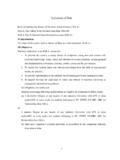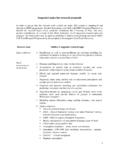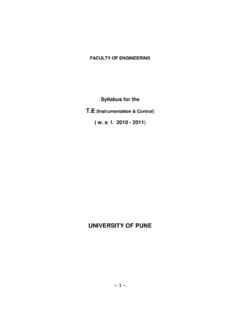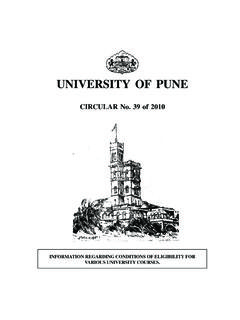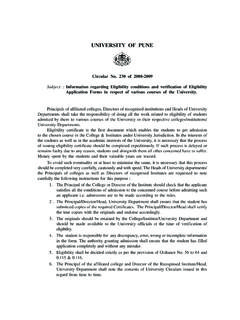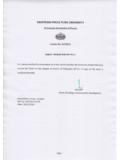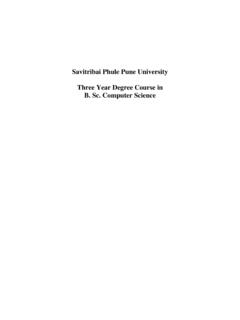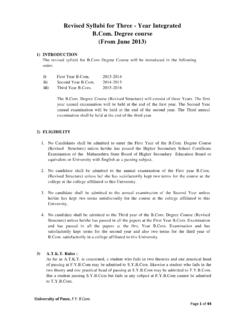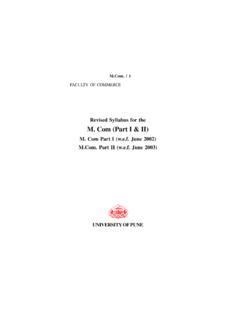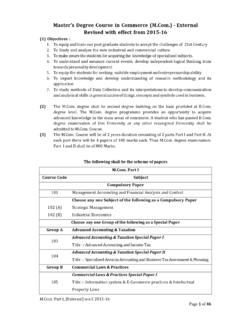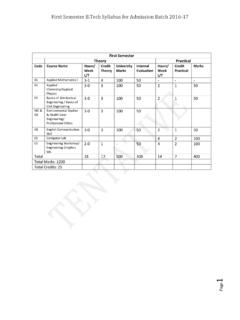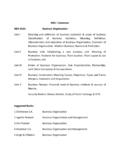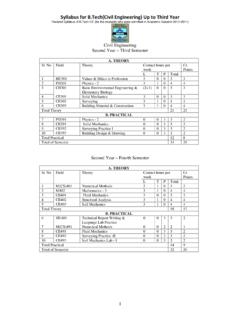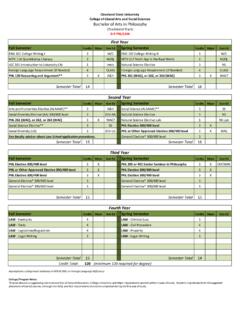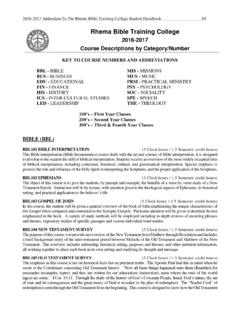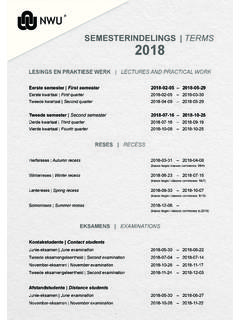Transcription of M.Sc. Chemistry Part- I Semester – I Semester – II
1 Chemistry part - I The following will be the structure for Revised Syllabus from June 2008 for Semester I and Semester II Semester I CH 110 Physical Chemistry I CH 130 Inorganic Chemistry I CH 150 Organic reaction mechanism and stereochemistry. CH 107 Physical Chemistry practical ( Departmental Course) CH 127 Inorganic Chemistry Practical ( Departmental Course) Semester II CH 210 Physical Chemistry II CH 230 Inorganic Chemistry II CH 250 Synthetic organic Chemistry and Spectroscopy. CH 290 General Chemistry ( Departmental Course) elective) CH 247 Organic Chemistry practical ( Departmental Course) Structure of part II :- ORGANIC Chemistry Semester : - III 1.
2 CH 350 Organic Reaction Mechanism 2. CH 351 Spectroscopic Methods in structure Determination 3. CH 352 A Organic Stereochemistry. B. Green Chemistry , Microwave reactions. 4. CH 353 Pericyclic Reactions, Free radicals and Photo Chemistry . Semester :- IV 1. CH 450 Chemistry Of Natural Products. 2. CH 451 Synthetic Methods in Organic Chemistry 3. CH 452 Heterocyclic Chemistry ; Chiron Approach; Medicinal Chemistry ; Vitamins, Hormones Antibiotics etc. 4. CH 453 Organic Molecules related to Nano matelial. Practical Courses:- 1. CH 347 Ternary Mixture Separation 2. CH 447 Two Stage Preparations.
3 3. CH 448 Project / Preparations Important Notes 1. Each theory course prescribed for M. Sc. should be covered in 4 periods, each of 60 minutes duration per week per course including lectures, tutorials, seminars etc. 2. Each practical course will require 6 hours of laboratory work per week and the course will be extended over two semesters and will be examined at the end of the year. 3. There should not be more than 10 students in a batch for M. Sc. practical course. 4. For theory course the question paper should include at least 20 % weight age for problem solving. Problem solving would include numerical, short answer, long answer questions to test understanding of the subject.
4 5. Of the 60 lectures in each course about 10 lectures will include tutorials, student seminars and class tests. 6. Two interactive sessions per course per Semester must be conducted by concerned teachers. PHYSICAL Chemistry CH 110 SECTION I TEHRMODYNAMICS 1) Recapitulation :- Heat, Work, & Conservation of energy The basic concepts, the first law, infinitesimal changes, mechanical work, work of compression & expansion, free expansion, Expansion against constant pressure, reversible expansion, Heat :- heat capacity, enthalpy. State functions & differentials state functions, Exact & Inexact differential, changes in internal energy, temperature dependence of the internal energy, Temperature dependence of the enthalpy.
5 Work of adiabatic expansion- Irreversible adiabatic expansion, reversible adiabatic expansion. Ref 1 Page No. 38 to 74 Periods 02 2) The Second law of Thermodynamics Measuring the dispersal the entropy, The second law, the definition of entropy, the entropy changes in the system, natural events. Entropy changes in the universe The enthalpy change when a system is heated, Entropy changes in surroundings, The entropy of phase transition, The entropy of irreversible changes. Concentrating on the system The Helmoltz & Gibbs function, some remarks on the Helmholtz function, Maximum work, some remarks to Gibbs function Evaluating the entropy & Gibbs function, The Third law of Thermodynamics, Third law entropies standard molar Gibbs function.
6 Ref 1 Page No. 96 to 117. Periods 05 3) Combining First & Second Law One way of developing the fundamental equations Properties of Gibbs function, The temperature dependence of the Gibbs functions, The pressure dependence of the Gibbs functions, The Chemical potential of a perfect gas, The open system & changes of composition. Ref 1 Page No. 121 127, 131. Periods 03 4) Changes of State : Physical Transformation of pure materials. The stability of phases, Phase equilibrium & phase diagrams, The solid liquid boundary, The liquid-vapour boundary, The solid- vapour boundary, The solid-liquid-vapour equilibrium.
7 Ref. 1 Pages 137 to 143. Periods 03 5) Changes of State Physical transformation of simple mixtures, Partial molar quantities Partial molar volume, Partial molar Gibbs function, The thermodynamics of mixing the Gibbs function of mixing after thermodynamics mixing functions, The chemical potential of liquid-liquid mixture, colligate properties- The common features, the elevation of boiling point, The depression of freezing point, solubility, osmosis, Mixtures of volatile liquid vapour pressure diagram The representation of distillation, azeotropes, immiscible liquids.
8 6) Changes of States Chemical reactions, Which way is downhill The Gibbs function minimum, Exergonic & endergonic reaction, perfect gas equilibria, A recipe for equilibrium constants real gas. Ref 1 Page-161 to 181, Ref. Page No. 212 to 217, Periods 07 QUANTUM Chemistry Historical development of quantum theory principal of quantum mechanics, wave particle duality, uncertainty principles, Schr dinger equation, operators simple system free particle, Particle in a box, Two dimensional Three dimensional box, Hydrogen like atoms ( no derivation ) atomic orbital.
9 Periods 10 Reference Books - 1. Physical Chemistry - Atkin, ELBS fourth edition. 2. Physical Chemistry Alberty, Bilby, Johy Wiley 1995 3. Physical Chemistry Barrow, Tata Mc Graw Hill 1988 4. Quantum Chemistry , - I . Levine, Fifth edition, Prentice Hall- 1999 5. Physical Chemistry Thomas Engel, Philip Reid. Section II 1. CHEMICAL KINETICS 1. Recapitulation:- Reaction rate, Rate law & rate constants, The determination of rate law, first order reactions, second order reactions, Half life. Ref 1 Page 689 to 697. Periods - 02 2. According for rate laws:- Simple reactions, The temperature dependence of reaction rates, Reaction approaching equilibrium consecutive reactions, The steady state approximations, Pre-equilibira, Unimolecular reactions, Enzyme catalysis Michaelis Menton mechanism, Lineweaver and Eadie plots, The kinetics of complex reaction, Chain reactions, the structure of chain reactions Explosions, - Fast reactions, flash photolysis, Flow technique, relaxation methods, Ref.
10 1 Page -698 to 708, Ref 1 Page 714 to 716 Ref1 Page 720 Ref. 1 Page 729 to 732 Period 12 3. Molecular reaction dynamics:- Collision theory basic calculation, the steric requirement, Diffusion controlled reactions- Classes of reactions, diffusion & reaction, the details of diffusion, Activated complex. The reaction co ordinate & transition state, the formulation & decay of the activated complex, How to use the Eyring equation. Thermodynamic aspect, reaction between ions, Dynamics of molecular collisions, Ref 1 Page 737 to 758. Period - 06 2. STATISTICAL THERMODYNAMICS Thermodynamic probability of a system, the moat probable distribution, the partition function, systems of independent particles, the energy of a system, the separation of partition function, The partition function for translation, The thermodynamic functions for translation, monochromic gases, Thermodynamic function for rotation, vibration, & Electronic excitation, Rotation, the electronic portion function, Results of statistical Calculation, statistical calculation of equilibrium constant, entropy & probability.
